Collaborative Action Toolkit
Developed by the Keystone Policy Center and Dow
Whether within or outside of organizations, parties, or sectors, longstanding solutions are most often generated out of successful partnerships and meaningful strategic relationships that open doors and enhance credibility on a critical topic. For more than 40 years, Keystone Policy Center has been called upon to empower leaders to harness the power of collaborative decision-making and build shared value with partners to achieve these mutually agreeable solutions.
Collaboration is a powerful concept that requires a methodical approach to be most effective. To streamline this approach and help other organizations foster collaboration, Keystone has partnered with Dow to create a step-by-step guide called the Collaborative Action Toolkit that provides a roadmap for anyone to develop a more collaborative mindset and organize their stakeholders and collaborations.
Learn more about the toolkit by listening the this episode of the Keynotes podcast:
The History of the Toolkit

Dow is nearly 25 years into its sustainability journey defined by the ambitious 2025 Sustainability Goals. Dow’s first set of decade-long sustainability goals was largely about Footprint reduction, reducing the impact of its operations. Dow’s second set of goals, focused on its global Handprint, producing more sustainable products alongside customers to address world challenges. These first two generations of goals delivered $6 billion in combined economic savings. Dow is currently in its third set, called the Blueprint Goals. These goals are about rethinking business models and collaborating with governments, NGOs, academia, and others to tackle global challenges, such as eliminating plastic waste, addressing climate change and enabling sustainable, reliable water supplies. These challenges require meaningful, purposeful collaborations. Dow recognized that this required a mindset shift from industry’s “business as usual” approach.
The Dow team developed a “Blueprint Thinking” process to create easy-to-follow collaboration roadmaps, or blueprints, that draw on the best practices of existing collaborations to make greater positive impacts for Dow and for society. Dow was ready to shift from incremental, operational efficiency changes within its own fenceline, many of which had successfully been implemented in previous decades of sustainability goals, and to transformational change that can only be achieved through collaborative thinking and multi-stakeholder involvement. Dow wanted to further develop its Blueprint Thinking process and create a toolkit to help employees navigate a multi-stakeholder collaborative approach to solving global challenges.
This is where Dow turned to Keystone. The Dow and Keystone teams worked closely together for a year to utilize Keystone’s expertise in broad collaborative stakeholder management and Dow’s real-world examples to create the Collaborative Action Toolkit. Dow tapped Keystone to identify key players, conduct an initial consultation about how and where stakeholder coordination would be helpful, identify barriers, and make recommendations for next steps.
Originally, this “Blueprint Thinking Toolkit” was tailored to Dow’s processes and designed to equip Dow’s employees with collaborative skills, but Dow and Keystone believe that the framework and lessons on developing a collaborative mindset could and should be available to everyone. The [Collaborative Action Toolkit] was the final product of that process. Dow’s Blueprint work, prominently including the collaboration with Keystone to produce the Collaborative Action Toolkit, was shortlisted in the 2020 Think Global Forum’s Award for the manufacturing sector to recognize companies that significantly contributed to global thought leadership activities.
What is the Toolkit?
The Collaborative Action Toolkit is an Excel workbook that provides a framework to navigate the internal and external planning, collaborations, and communications required in considering external engagement for a complex issue or project.
The toolkit is organized into three sections—project alignment, stakeholder mapping, external engagement—and provides numerous tools for each stage. Since collaboration is not always a linear process, and different partnerships require different starting points, the toolkit is built to be easily-adaptable so no matter what stage a collaborative initiative may be in, it can serve to reinforce what you have built and achieve your goals.

Case Study: Sustainable Watershed Management
Dow’s blueprint on Sustainable Watershed Management helped the organization develop a tailored collaborative approach for external engagement on its watershed management goals. The following learnings occurred by working through the toolkit:

- Project Alignment: Dow identified three priority areas in watershed management but also realized that with so many organizational changes, there were no clear internal “owners” or “drivers” for Dow’s water strategy. Dow decided to focus on creating a catalogue or one-stop-shop of water-related case studies to share internally and externally.
- Stakeholder Mapping: Dow determined that applying broad stakeholder mapping techniques for large-scale water collaborations would be difficult and not as helpful because many water collaborations are local and site-specific, requiring miniature stakeholder maps and collaboration roadmaps for each site.
- External Engagement: Dow created a page on its website to share case studies and priorities on watershed management. The case studies provide best practices that are simple to implement for other organizations looking to achieve watershed management sustainability initiatives.
Dow utilized the toolkit to develop and align internal strategic priorities, develop a plan for engagement with stakeholders, and deploy a strategy of external engagement to help make the organization a leader among those looking to prioritize sustainability goals and initiatives.
Case Study: Water Use in Terneuzen, Netherlands
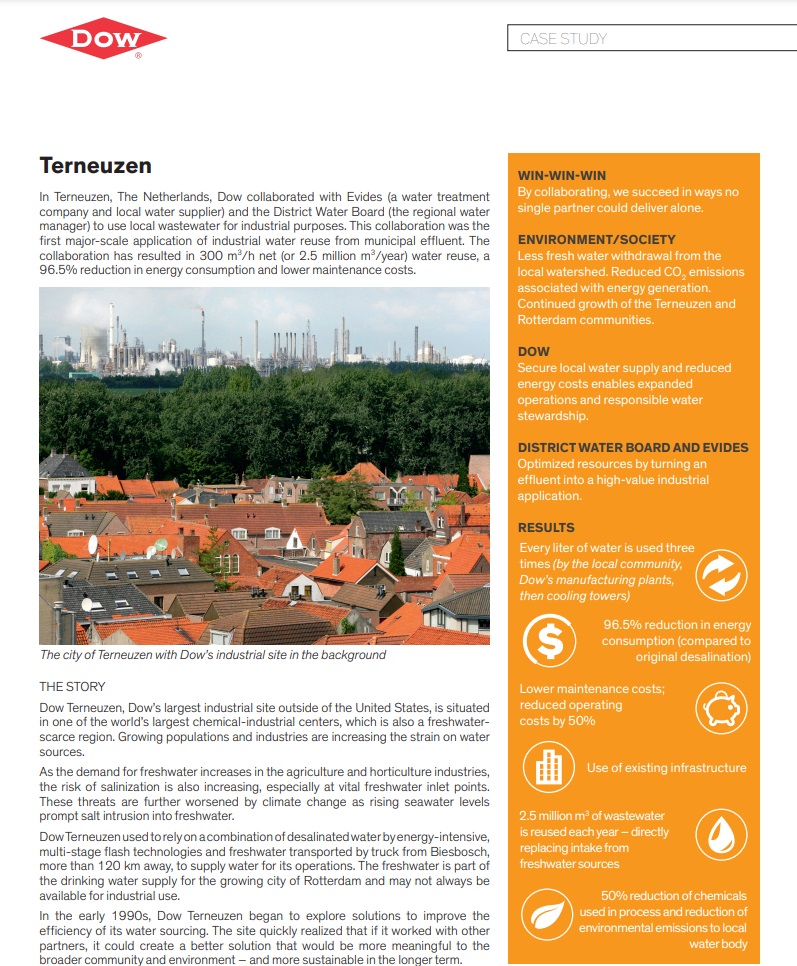
Dow’s blueprint on Sustainable Watershed Management highlights Dow’s collaborative approach to watershed management in the communities where they live and work. Notably, a case study on the first-of-its-kind watershed collaboration to reuse local municipal water for Dow’s industrial processes in Terneuzen, The Netherlands is included in the blueprint, which exemplifies the Blueprint Thinking (Collaborative Action) process.
The Terneuzen site is located in a freshwater scarce region. Growing populations and manufacturing needs are straining water sources, and rising sea levels threaten the fresh water supply. Additionally, the site withdraws fresh river water near sensitive wetlands of international importance. Historically, Dow imported freshwater from 120 kilometers away which was not a sustainable long-term solution for the watershed or for Dow. The Dow Terneuzen team began to look for opportunities to decrease its long-term dependence on fresh water sources and knew this could only be done in a collaborative approach with local stakeholders. They sought the input and partnership of local water suppliers, municipalities, and stakeholders to reuse the local municipal water in Dow’s manufacturing processes and, today, they reuse or recycle 75-80% of the site’s water requirements. Dow Terneuzen is continuing to innovate with local water users, suppliers and governments to find ways to preserve water in its local watersheds towards a goal of zero fresh water imports for manufacturing by 2025. They are exploring methods to capture and process local water sources like rain water and other industrial streams, as well as expanding usage of Terneuzen municipal water. This year, they jointly invested in an additional municipal reuse pilot. The total water need at the site per year is equivalent to the average water consumption of 400,000 households. Not only would the usage of these additional sources eliminate the need for water from remote sources for Dow’s industrial use, but it could secure an additional 6-8 million m3/year of water for use by various sectors such as agriculture or industry, amplifying the success of this collaborative work beyond Dow and the local stakeholders but to the entire region.


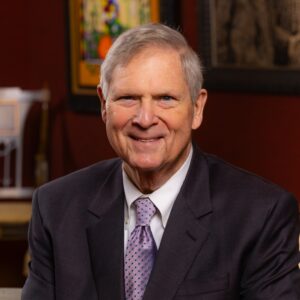 Effective March 1, 2025, Thomas J. Vilsack, former United States Secretary of Agriculture and Governor of Iowa, became the first Chief Executive Officer for the World Food Prize Foundation. In this new role, Governor Vilsack is focusing on expanding the Foundation’s global network, and will further position the Foundation as a leader in addressing global food and nutrition insecurity, continuing his lifetime of public service.
Effective March 1, 2025, Thomas J. Vilsack, former United States Secretary of Agriculture and Governor of Iowa, became the first Chief Executive Officer for the World Food Prize Foundation. In this new role, Governor Vilsack is focusing on expanding the Foundation’s global network, and will further position the Foundation as a leader in addressing global food and nutrition insecurity, continuing his lifetime of public service. Shelby Coffey III is a distinguished journalist, media executive, and thought leader whose career has helped shape the landscape of American news and public discourse. Over several decades, Coffey has held some of the most influential roles in journalism, including serving as editor of the Los Angeles Times, executive vice president of ABC News, and deputy managing editor of The Washington Post. His editorial leadership extended to key roles as president of CNN Financial News, editor of the Dallas Times Herald, and U.S. News & World Report.
Shelby Coffey III is a distinguished journalist, media executive, and thought leader whose career has helped shape the landscape of American news and public discourse. Over several decades, Coffey has held some of the most influential roles in journalism, including serving as editor of the Los Angeles Times, executive vice president of ABC News, and deputy managing editor of The Washington Post. His editorial leadership extended to key roles as president of CNN Financial News, editor of the Dallas Times Herald, and U.S. News & World Report.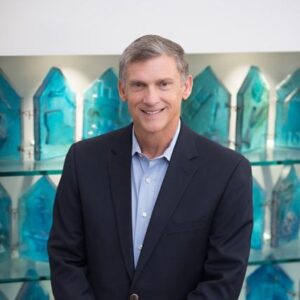 Jerry Steiner has spent 40 years involved in agriculture following growing up on a Wisconsin dairy farm. He began his career with Monsanto, in multiple business leadership roles. From 2003-2013 he served as a member of the Executive team, as the company’s Executive Vice President of Sustainability and Corporate Affairs. He led the company’s global Government, Public and Industry Affairs teams across the 70 countries where Monsanto conducts business. This experience got Jerry connected to the Keystones centers work in agriculture. Key among his responsibilities were shaping the company’s public policy and building partnerships aimed at helping farmers around the world produce more food, while conserving valuable resources like water and energy. Two unique partnership that developed under his leadership were drought tolerant corn with 5 African countries, CIMMYT and the Gates foundation, and a building a sustainable business model in Brazil with the value chain leading to significant multi-company investment and soybean varieties that can protected themselves.
Jerry Steiner has spent 40 years involved in agriculture following growing up on a Wisconsin dairy farm. He began his career with Monsanto, in multiple business leadership roles. From 2003-2013 he served as a member of the Executive team, as the company’s Executive Vice President of Sustainability and Corporate Affairs. He led the company’s global Government, Public and Industry Affairs teams across the 70 countries where Monsanto conducts business. This experience got Jerry connected to the Keystones centers work in agriculture. Key among his responsibilities were shaping the company’s public policy and building partnerships aimed at helping farmers around the world produce more food, while conserving valuable resources like water and energy. Two unique partnership that developed under his leadership were drought tolerant corn with 5 African countries, CIMMYT and the Gates foundation, and a building a sustainable business model in Brazil with the value chain leading to significant multi-company investment and soybean varieties that can protected themselves. Jennifer Morris is the Chief Executive Officer of The Nature Conservancy, leading a team of nearly 6,000 staff working in more than 80 countries and territories tackling the dual crises of the
Jennifer Morris is the Chief Executive Officer of The Nature Conservancy, leading a team of nearly 6,000 staff working in more than 80 countries and territories tackling the dual crises of the 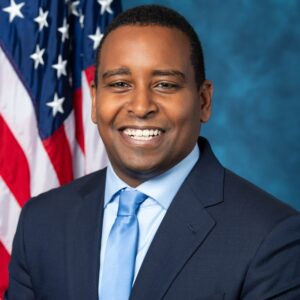 Congressman Joe Neguse represents Colorado’s 2nd District in the U.S. House of Representatives. He was elected to his first term in November 2018, becoming the first Black Member of Congress in Colorado history. In December 2022, Rep. Neguse was elected by his colleagues to serve as Chair of the Democratic Policy and Communications Committee (DPCC), becoming the first Coloradan to serve in a senior elected leadership role in the House in over 85 years. He serves on the Natural Resources and Judiciary Committees, and was also appointed by House Minority Leader Hakeem Jeffries to serve as one of four Democrats on the prestigious Rules Committee. Rep. Neguse serves as Ranking Member on the House Subcommittee on Federal Lands, which he previously Chaired in the 117th Congress.
Congressman Joe Neguse represents Colorado’s 2nd District in the U.S. House of Representatives. He was elected to his first term in November 2018, becoming the first Black Member of Congress in Colorado history. In December 2022, Rep. Neguse was elected by his colleagues to serve as Chair of the Democratic Policy and Communications Committee (DPCC), becoming the first Coloradan to serve in a senior elected leadership role in the House in over 85 years. He serves on the Natural Resources and Judiciary Committees, and was also appointed by House Minority Leader Hakeem Jeffries to serve as one of four Democrats on the prestigious Rules Committee. Rep. Neguse serves as Ranking Member on the House Subcommittee on Federal Lands, which he previously Chaired in the 117th Congress.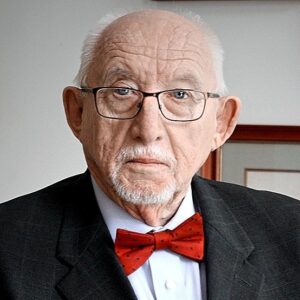 Llewellyn King was born in Southern Rhodesia, now Zimbabwe. He went into journalism as soon as he turned 16, stringing for Time magazine and United Press in Africa.
Llewellyn King was born in Southern Rhodesia, now Zimbabwe. He went into journalism as soon as he turned 16, stringing for Time magazine and United Press in Africa.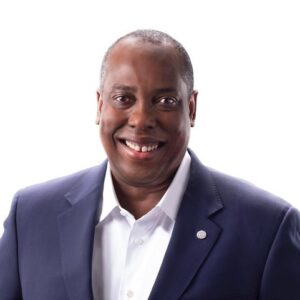 Steven Williams is the Chief Executive Officer of PepsiCo North America, overseeing a more than $48 billion business that spans PepsiCo’s Foods and Beverage operating units. His leadership encompasses more than 125,000 associates and over 900 locations across the U.S. and Canada. Steven joined PepsiCo in 2001 as part of PepsiCo’s acquisition of the Quaker Oats Company, which he joined in 1997, and has held leadership positions of increased responsibility since.
Steven Williams is the Chief Executive Officer of PepsiCo North America, overseeing a more than $48 billion business that spans PepsiCo’s Foods and Beverage operating units. His leadership encompasses more than 125,000 associates and over 900 locations across the U.S. and Canada. Steven joined PepsiCo in 2001 as part of PepsiCo’s acquisition of the Quaker Oats Company, which he joined in 1997, and has held leadership positions of increased responsibility since.